Intro
Discover the ultimate Na Lab Test Guide, covering normal sodium levels, lab test procedures, and interpreting results for hypernatremia and hyponatremia diagnosis, with expert insights on electrolyte balance and clinical significance.
Laboratory tests are a crucial part of medical diagnosis and treatment. They help healthcare professionals understand the underlying causes of symptoms, monitor the progression of diseases, and evaluate the effectiveness of treatments. Among the various types of lab tests, the Na (sodium) lab test is one of the most common and essential. In this article, we will delve into the world of Na lab tests, exploring their importance, working mechanisms, and key aspects related to the topic.
The human body relies on a delicate balance of electrolytes, including sodium, to function properly. Sodium plays a vital role in maintaining fluid balance, nerve function, and muscle contraction. An imbalance of sodium levels can lead to various health issues, such as dehydration, seizures, and heart problems. Therefore, it is essential to monitor sodium levels regularly, especially for individuals with certain medical conditions or those taking specific medications. The Na lab test is a simple and effective way to measure sodium levels in the blood, providing valuable insights into a person's overall health.
The Na lab test is typically performed as part of a routine medical checkup or when a healthcare professional suspects an electrolyte imbalance. The test involves collecting a blood sample from a vein in the arm, which is then sent to a laboratory for analysis. The results are usually available within a few hours, and they can help diagnose a range of conditions, including hypernatremia (elevated sodium levels), hyponatremia (low sodium levels), and adrenal insufficiency. By understanding the results of the Na lab test, healthcare professionals can develop targeted treatment plans to address underlying health issues and prevent complications.
Understanding the Na Lab Test
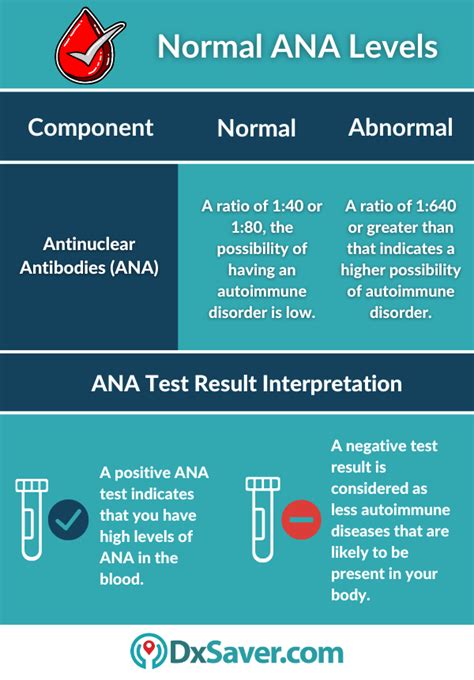
The Na lab test measures the concentration of sodium in the blood, which is typically expressed in units of milliequivalents per liter (mEq/L). The normal range for sodium levels is between 135 and 145 mEq/L, although this can vary slightly depending on the laboratory and individual factors. To interpret the results of the Na lab test, healthcare professionals consider various factors, including the patient's medical history, symptoms, and other laboratory results. For example, a high sodium level may indicate dehydration, while a low sodium level may suggest overhydration or adrenal insufficiency.
Preparation and Procedure
The preparation and procedure for the Na lab test are relatively straightforward. Patients are usually required to fast for 8-12 hours before the test, although this may vary depending on the specific laboratory and healthcare provider. The test itself involves collecting a blood sample from a vein in the arm, which is typically performed by a phlebotomist or healthcare professional. The blood sample is then sent to a laboratory for analysis, where the sodium levels are measured using specialized equipment.Interpreting Na Lab Test Results
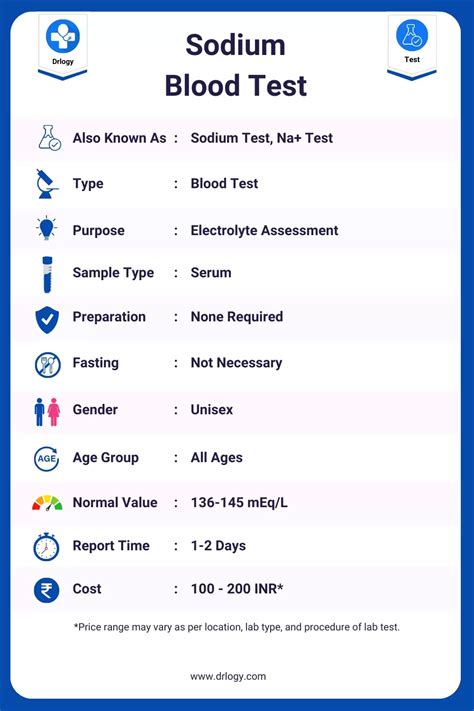
Interpreting the results of the Na lab test requires careful consideration of various factors, including the patient's medical history, symptoms, and other laboratory results. The following are some general guidelines for interpreting Na lab test results:
- Normal sodium levels: 135-145 mEq/L
- Elevated sodium levels (hypernatremia): above 145 mEq/L
- Low sodium levels (hyponatremia): below 135 mEq/L Healthcare professionals use these guidelines to develop targeted treatment plans, which may include medications, lifestyle changes, or other interventions. For example, patients with hypernatremia may require fluid replacement therapy, while those with hyponatremia may need to restrict fluid intake.
Treatment and Management
The treatment and management of sodium imbalances depend on the underlying cause and severity of the condition. In some cases, patients may require hospitalization to receive intravenous fluids or other treatments. In other cases, patients may be able to manage their condition through lifestyle changes, such as adjusting their diet or fluid intake. The following are some common treatments for sodium imbalances: * Fluid replacement therapy: to treat dehydration or hypernatremia * Fluid restriction: to treat overhydration or hyponatremia * Medications: to treat underlying conditions, such as adrenal insufficiency * Dietary changes: to manage sodium intake and prevent future imbalancesBenefits and Risks of the Na Lab Test
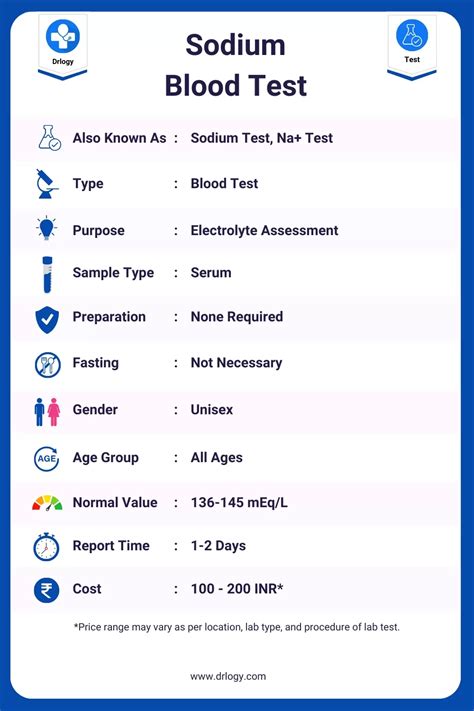
The Na lab test is a valuable diagnostic tool that offers several benefits, including:
- Accurate diagnosis: of sodium imbalances and related conditions
- Targeted treatment: to address underlying health issues and prevent complications
- Monitoring: to track the effectiveness of treatments and adjust them as needed However, the Na lab test also carries some risks, including:
- Bleeding or bruising: at the blood collection site
- Infection: at the blood collection site
- Allergic reactions: to the blood collection procedure or laboratory equipment To minimize these risks, healthcare professionals follow strict protocols for collecting and analyzing blood samples.
Common Conditions Diagnosed with the Na Lab Test
The Na lab test is used to diagnose a range of conditions, including: * Hypernatremia: elevated sodium levels * Hyponatremia: low sodium levels * Adrenal insufficiency: a condition in which the adrenal glands do not produce enough hormones * Dehydration: a condition in which the body loses too much fluid * Overhydration: a condition in which the body retains too much fluid These conditions can have serious consequences if left untreated, emphasizing the importance of regular sodium level monitoring and prompt treatment.Na Lab Test and Other Medical Conditions
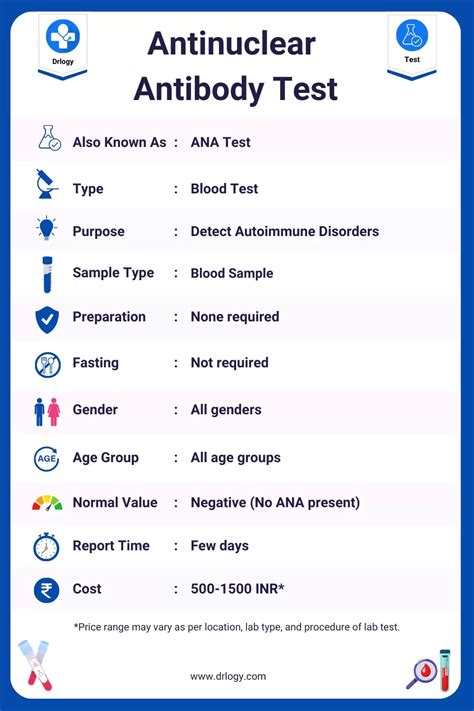
The Na lab test is often used in conjunction with other medical tests to diagnose and manage a range of conditions. For example:
- Kidney function tests: to evaluate kidney function and detect potential problems
- Liver function tests: to evaluate liver function and detect potential problems
- Electrolyte panels: to measure the levels of other electrolytes, such as potassium and chloride
- Blood glucose tests: to measure blood sugar levels and diagnose conditions like diabetes By combining the results of these tests, healthcare professionals can develop a comprehensive understanding of a patient's health and provide targeted treatment.
Na Lab Test and Medications
Certain medications can affect sodium levels, emphasizing the importance of careful monitoring and management. For example: * Diuretics: can increase sodium levels by promoting fluid loss * Steroids: can increase sodium levels by promoting fluid retention * Blood pressure medications: can affect sodium levels by altering blood vessel function Healthcare professionals must consider these factors when interpreting Na lab test results and developing treatment plans.Na Lab Test and Lifestyle Changes
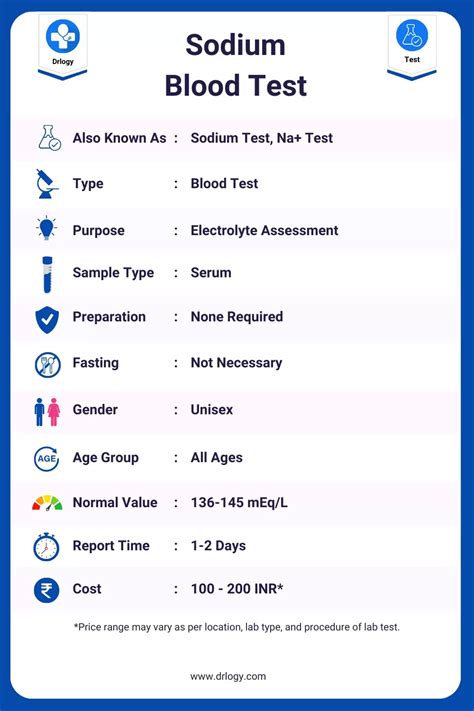
Lifestyle changes can play a crucial role in managing sodium levels and preventing imbalances. For example:
- Dietary changes: to manage sodium intake and prevent future imbalances
- Fluid intake: to stay hydrated and prevent dehydration
- Exercise: to promote overall health and well-being By making these changes, individuals can reduce their risk of developing sodium-related health issues and improve their overall quality of life.
Na Lab Test and Pregnancy
Pregnancy can affect sodium levels, emphasizing the importance of careful monitoring and management. For example: * Morning sickness: can lead to dehydration and electrolyte imbalances * Fluid retention: can lead to overhydration and electrolyte imbalances * Preeclampsia: a condition characterized by high blood pressure and electrolyte imbalances Healthcare professionals must consider these factors when interpreting Na lab test results and developing treatment plans for pregnant women.Na Lab Test and Children

Children are more susceptible to sodium imbalances due to their smaller body size and developing physiology. For example:
- Dehydration: can lead to electrolyte imbalances and serious health complications
- Overhydration: can lead to electrolyte imbalances and serious health complications
- Kidney disease: can affect sodium levels and overall health Healthcare professionals must consider these factors when interpreting Na lab test results and developing treatment plans for children.
Na Lab Test and Older Adults
Older adults are more susceptible to sodium imbalances due to age-related changes in physiology. For example: * Dehydration: can lead to electrolyte imbalances and serious health complications * Overhydration: can lead to electrolyte imbalances and serious health complications * Kidney disease: can affect sodium levels and overall health Healthcare professionals must consider these factors when interpreting Na lab test results and developing treatment plans for older adults.What is the normal range for sodium levels in the blood?
+The normal range for sodium levels in the blood is between 135 and 145 mEq/L.
What are the symptoms of hypernatremia?
+The symptoms of hypernatremia can include thirst, dark urine, and dizziness.
How is the Na lab test performed?
+The Na lab test is performed by collecting a blood sample from a vein in the arm, which is then sent to a laboratory for analysis.
In conclusion, the Na lab test is a valuable diagnostic tool that plays a crucial role in managing sodium levels and preventing related health issues. By understanding the importance of the Na lab test, its working mechanisms, and key aspects related to the topic, individuals can take proactive steps to maintain their overall health and well-being. We invite you to share your thoughts and experiences with the Na lab test in the comments section below. If you found this article informative, please share it with your friends and family to help them understand the importance of sodium level monitoring.
